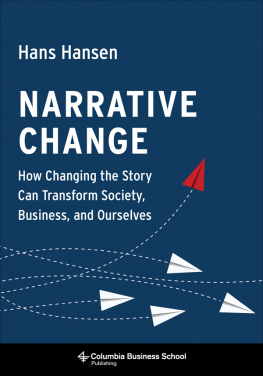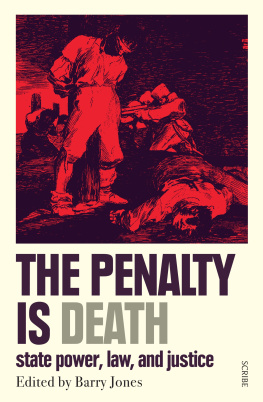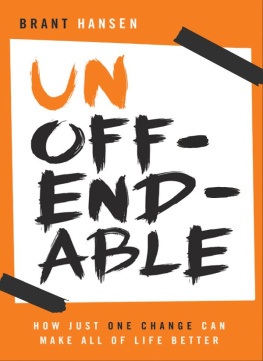Table of Contents
NARRATIVE CHANGE
Columbia University Press
Publishers Since 1893
New York Chichester, West Sussex
cup.columbia.edu
Copyright 2020 Columbia University Press
All rights reserved
E-ISBN 978-0-231-54548-8
Library of Congress Cataloging-in-Publication Data
Names: Hansen, Hans (College teacher), author.
Title: Narrative change: how changing the story can transform society, business, and ourselves / Hans Hansen.
Description: New York: Columbia University Press, [2020] | Includes bibliographical references and index.
Identifiers: LCCN 2019051925 (print) | LCCN 2019051926 (ebook) | ISBN 9780231184427 (hardback) | ISBN 9780231545488 (ebook)
Subjects: LCSH: Narrative inquiry (Research method) | Capital punishmentTexas. | Social change.
Classification: LCC H61.295 .H37 2020 (print) | LCC H61.295 (ebook) | DDC 364.6609764dc23
LC record available at https://lccn.loc.gov/2019051925
LC ebook record available at https://lccn.loc.gov/2019051926
A Columbia University Press E-book.
CUP would be pleased to hear about your reading experience with this e-book at .
Cover design: Lisa Hamm
Cover image: lukbar/Adobe Stock
Contents
I would like to thank the Texas Regional Public Defender Office for Capital Cases for inviting me to work with them in fighting the death penalty, and for allowing me to conduct ethnographic research on their work and lives. I am particularly grateful to Philip Wischkaemper and Jack Stoffregen for giving me unprecedented access to a remarkable setting and for their willingness to try innovative approaches to stop executions. I also want to congratulate them on their tremendous success in changing the way the death penalty works in Texas. I am grateful to my family and my colleagues for supporting my work. I am also thankful for the guidance of my editor, Myles Thompson, at Columbia University Press.
T his book offers a model of change for everyone, but it emerged from an unlikely tale of a small group of people who managed to change the way the death penalty operates in Texas. I have since tried, tested, and refined the model and applied it in a variety of settings. I am now confident enough to release it so others can benefit from what I have learned about the processes of change.
On one hand, this book came out of the blue. Changing the death penalty, a Goliath of an institution, began with an unexpected phone call from a lawyer wanting me to help build a small team of people. He was vague on the phone, and I agreed to meet with him, but only to get some more details about this new team and suggest someone more suitable than me to help them.
On the other hand, this book has been in the making for more than twenty years. I can see how all of my past experiences, even my shortcomingsmaybe especially my shortcomingsprepared me for the challenge I faced in fighting the death penalty. Planned or unplanned, all of my experiences forged in me a perspective of change that would become invaluable.
Our tremendous success was unlikely. No one, not even the death penalty team members, ever imagined we would accomplish what we did. The team has stopped well over one hundred executions against nearly insurmountable odds. During my time with the team, we were 70 and 1, and now the team is 165 and 4.
This story begins in West Texas, where the powerful state got death sentences in capital trials more than 90 percent of the time. I learned a lot in working to change an extremely ingrained institution, and I think the same processes and model I used could work for any team, organization, or individual.
I knew I had to share it.
Recently, I had the opportunity to spend some time with someone I had long admired, Sister Helen Prejean. Sister Helen is the famous Catholic nun who wrote Dead Man Walking, which described her relationship with a death row inmate and her witness to the effects of the death penalty on everyone involved. Susan Sarandon played Sister Helen in the critically acclaimed movie of the same name and won an Academy Award.
Sister Helen and I shared our joys and struggles in wrestling with the death penalty, both of us having gone from unwitting outsiders to central players. I was so happy to finally meet someone whose introduction to the death penalty reflected my own. Neither Sister Helen nor I ever had any intention of getting involved with death penalty cases. In her case, someone casually suggested she write to a man in prison.
I thought I was getting some sort of pen pal! Sister Helen told me.
My introduction was that unexpected phone call requesting a meeting with a couple of lawyers who wanted advice on team building.
I am an ethnographer, which means I am a professional outsider-cum-insider. Learning how the death penalty works in practice was eye-opening and jaw-dropping. Attempting to fight it, much less stop it, seemed impossible. The death penalty is a brutal, unrelenting beast, and I felt like a bewildered nincompoop who had accidently wandered into the ring with a monster.
Mirroring my own feelings, Sister Helen told me one of her favorite stories about her own lack of readiness involving a movie production meeting with director Tim Robbins and Susan Sarandon. They were discussing characterization for various movie roles when Tim surmised: Clearly, the nun is in over her head.
And I was! Sister Helen laughed.
It was cathartic for me to hear that Sister Helen and I shared so many of the same emotions in our respective journeys. I too felt ill equipped and unprepared for what lay ahead once I agreed to help the death penalty defense team change the way they did things. If this is fate, I once told a crowd, she could not have picked worse.
I did not want to get involvedin anything. I had made a pretty conscious decision to hide from the world, not fight one of its most menacing demons. But something pulled me in, or maybe I jumped. I like to think I yearned to make a difference, but maybe I knew it might just save my life.
In the early days, I kept asking, What if we try this? while spit-balling strategies to fight the death penalty.
Experienced experts kept saying, Its never been done, but lets try it.
It was nerve-racking. Even though I was confident, it never escaped me that lives were on the line. I shared my fears by reminding the team, constantly, that I was only there by mistake.
Or luck, someone said.
Either way, I felt like I did not belong. Over time, I grew into the task, and we were enormously successful. Death penalty defense has changed. So have I. My broader ideas about managing and leading change have been tested and refined, and now I want to share them with you. If you face a change challenge, whether you have sought it or it has fallen to you, I think you will find the ideas in this book useful.
No matter the size of the job, or how intractable the problems may seem, you can change the ways thing are.
Out of respect for the families of the victims, names and other identifying details in several of the cases have been changed.
T his book is about leading change by creating and enacting new narratives. The simplest and broadest conceptualization of change is moving from the old way of doing things to a new way of doing things. Although this is easily said, making these changes entails understanding many subtle processes that we rarely examine. To lead transformational change, we need to devote attention to two main processes. The firstthe most overlooked aspect of change in both our theories and practicesis overcoming or resisting pressures to keep doing things the same way we have always done things. The second is enacting change, bringing new ideas and vision into the real world. My method calls for creating and enacting narratives.













